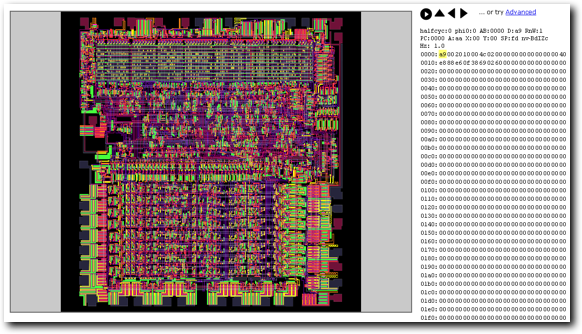Todays 6502 spotlight will not be about one of the many fun, diverse, quirky homecomputers from the late 70's, 80's and early 90's. Instead it will be about a website. Naturally, websites make for poor computers, let alone CPU's...
Or do they?
This one is different and is so incredibly cool* I just had to share it. Even though it doesn't work in all browsers and needs a rather heftier computer than any of my Commodores can ever be. In fact, you'll need a pretty up to date Mac / PC or laptop to be able to view it at any reasonable speed.
The site I'm referring to is the rather excellent Visual6502.org, on which you can see the result of painstaking work to recreate the MOS6502 - visually. You can run 6502 code on it and see just how the different parts of CPU interact in executing your code. It is very neat, since it gives a view of how early CPU's work which is hard to put in words.
It is also very accurate, because the team involved build this 6502 simulator by creating a polygon model of the actual CPU die, which they scanned at very high resolutions. Then, they created a simulation which could use said polygons to act as if they were the actual transistors and other components in a CPU. The result is that the simulation executes the code you enter just like a real 6502 would, in the same order.
This is very different from how 'ordinary' emulators go about things and apart from being very accurate, it's also very interesting to see in motion.
Or do they?
This one is different and is so incredibly cool* I just had to share it. Even though it doesn't work in all browsers and needs a rather heftier computer than any of my Commodores can ever be. In fact, you'll need a pretty up to date Mac / PC or laptop to be able to view it at any reasonable speed.
The site I'm referring to is the rather excellent Visual6502.org, on which you can see the result of painstaking work to recreate the MOS6502 - visually. You can run 6502 code on it and see just how the different parts of CPU interact in executing your code. It is very neat, since it gives a view of how early CPU's work which is hard to put in words.
It is also very accurate, because the team involved build this 6502 simulator by creating a polygon model of the actual CPU die, which they scanned at very high resolutions. Then, they created a simulation which could use said polygons to act as if they were the actual transistors and other components in a CPU. The result is that the simulation executes the code you enter just like a real 6502 would, in the same order.
This is very different from how 'ordinary' emulators go about things and apart from being very accurate, it's also very interesting to see in motion.

Above: Simulating a simple program on the 6502.
The simulation was first shown to the world on the 27th of July 2010, during the Siggraph 2010 conference. Unlike Skynet, which was also made using technology far beyond human understanding**, it did not become self aware. It does run 6502 assembly code though, which is nearly as good!
Sadly, this amazing technology does have some minor niggles - the HTML5 application which does the simulation won't work in all browsers and specifically seems to dislike all Commodore 64/128 browsers, most (if not all) Amiga browsers and.... Internet Explorer (at least up to version 8).
Keep this in mind when you check it out - if you still use Internet Explorer: use the latest version. Failing that, try another browser altogether.
Sadly, this amazing technology does have some minor niggles - the HTML5 application which does the simulation won't work in all browsers and specifically seems to dislike all Commodore 64/128 browsers, most (if not all) Amiga browsers and.... Internet Explorer (at least up to version 8).
Keep this in mind when you check it out - if you still use Internet Explorer: use the latest version. Failing that, try another browser altogether.
Why it is interesting:
- It allows you to see how the processor works and which instructions use what part of the 6502.
- It has an extremely accurate simulation of the 6502, running straight from your browser!
- There is also a wiki with tons of info, a simulator of the Motorola 6800, using the same visual display, etc!
Direct links:
- Main site: www.visual6502.org
- The 6502 simulator: www.visual6502.org/JSSim/index.html
Personal notes about Visual6502.org:
- I really like this site, so many sites these days offer no real in depth content, this site goes against the grain by going way overboard in detail.
- Watching the execution of the demo program is somehow soothing and almost hypnotic with its colours moving about.
- Processor die shots are always nice, this site has plenty of the Atari/Commodore/AMD/Intel classics.
- Here's hoping for a visual MOS6569, MOS6581, etc. I'd love to see them tackle a whole Commodore 64 at once :)
*) That is to say, I think it is. Which is good enough for me ;)
**) Hey, what can I say - Translating polygons into simulated electrical components and then running said result and getting it all to work, all based on -effectively- some photo's made of a 1970's CPU core is not something I'd personally be able to do 'right away'...
**) Hey, what can I say - Translating polygons into simulated electrical components and then running said result and getting it all to work, all based on -effectively- some photo's made of a 1970's CPU core is not something I'd personally be able to do 'right away'...